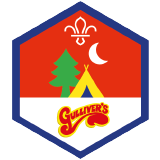
Play Tree Switch
Love trees?
If you want to take your love of trees further, why not check out our partnership with the Green Tree Badge. This will give you the opportunity to engage with trees in a new way and earn external badges along the way!
Green Tree BadgeBefore you begin
- Use the safety checklist to help you plan and risk assess your activity. Additional help to carry out your risk assessment, including examples.
- Make sure all young people and adults involved in the activity know how to take part safely.
- Make sure you’ll have enough adult helpers. You may need some parents and carers to help if you’re short on helpers.
Planning this activity
- Make sure the outdoor area you visit is accessible for everyone, choosing a suitable place for drop off and collection. You may need to think about avoiding steps or steep gradients or including frequent breaks.
- Check the forecast and sunset times, but be prepared for the weather to change. It’s best to run this activity on lighter evenings, such as in summer.
- Make sure everyone knows where and when to meet, knows what to bring and comes dressed for the weather and the task. People should wear outdoor clothing and sturdy shoes.
- It might be a good idea to have some spare equipment, such as gardening gloves, for those who’d prefer not to get their hands too dirty. Make sure there’s somewhere everyone can wash their hands after the activity too.
- Find a wood that has a variety of trees – try to make sure that there are at least three or four of some of the trees that are on the leaf spotter sheet.
- Print enough copies of the Leaf hunt sheet, so that each group has one between them. Alternatively, find or make your own sheets, or use an app such as the Woodland Trust Tree ID app.
- Ideally, you want one player for each tree, but it’s OK if there are two or three players for each tree. The boundaries of the playing area can be as wide as you like, but everyone should stay in sight. Adults could stand around the boundary.
Play the game
- Gather everyone in a circle and give out the ‘Leaf ID’ sheets.
- Ask everyone to look around the space and explain which trees are included in the game, as well as where the boundaries are.
- Everyone should help identify the trees that are included in the game, using their ‘Leaf ID’ sheets.
- If you find any that aren’t on the sheet, then someone could take a photo of the leaf to identify it later on.
- Choose one person to be the tree caller.
- Divide all of the other players between the trees in the game. They should divide people evenly, so the same number of people are touching each tree. You may need adults or young leaders to help balance the numbers out.
- Tell everyone that only a certain number of people can be touching a tree at once, so if the tree is already ‘full’ they’ll need to find another tree to go to.
- The tree caller should stand in the middle of the tree area. They should call out the name of a tree.
- Everyone touching that type of tree should leave that tree and move carefully to another tree of the same type.
- If the tree caller calls out the word ‘forest’, everyone should leave their tree and move to find another space.
- While the players are moving, the tree caller should try to find a free space on a tree in the game.
- If the tree caller finds a space, the person who’s left without a free space becomes the tree caller. If the tree caller doesn’t find a space, they stay as the tree caller.
- Whoever’s the tree caller should keep calling out trees until it’s time to finish the game.
Reflection
This activity was a chance to value the outdoors. Sit and look at the trees. Everyone should notice their shapes, bark, leaves, and branches; all of the trees are different! Why are trees so important? People may think about how they help us breathe by acting like natural air purifiers, how they’re a home for birds, animals, and insects, and how fallen leaves act as a natural compost for the forest floor. If they want to, people could thank the trees before they head back to their meeting place. How might people thank the trees? Some people may say ‘thank you’ and others may give them a hug.
This activity also needed everyone to be active. People will probably need a rest after such an energetic game. The game was about having fun while getting a bit of exercise too. Does everyone feel tired? It’s good to find exercise that you enjoy – did you enjoy the risk and competition in this game?
Safety
All activities must be safely managed. You must complete a thorough risk assessment and take appropriate steps to reduce risk. Use the safety checklist to help you plan and risk assess your activity. Always get approval for the activity, and have suitable supervision and an InTouch process.
- Outdoor activities
You must have permission to use the location. Always check the weather forecast, and inform parents and carers of any change in venue.
Use as many kinds of trees as you can, especially if there are lots in your local area. Make sure everyone understands each step of the game before you move on.
Make sure the playing area is accessible to everyone.
All Scout activities should be inclusive and accessible.
Why not combine the game with a longer walk or hike around the area to spot more trees?
People can take it in turns to lead the game.

